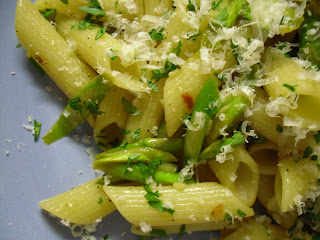The notion of “tuna noodle casserole” keeps finding its way to me. First, it was a friend’s nostalgia about a roommate’s version of the recipe in college (Annie’s “Alfredo Style” mac and cheese, mixed with tuna, and topped with potato chips). Then it was a feature recipe in March’s Bon Appétit (all gussied up with leeks, fresh dill, and béchamel sauce). Additionally, I’ve been eating more tuna salad lately because I’m bored to death with my standby lunch of turkey sandwiches. I know: tuna lacks glamour, and it tends to conjure up images of elderly couples splitting sandwiches on pumpernickel, but it has potential with the right preparation. Ironically, there were many years when I wouldn’t even eat tuna, and I am still hesitant to eat tuna salad prepared by anyone other than myself and a few relatives. However, between my turkey sandwich rut and my tight financial situation, tuna’s stock is currently up.
Last weekend, during one of my maze-like Internet binges of all things food-related, I found the perfect recipe for tuna noodle casserole. I believe Tastespotting led me to it, but I can’t be certain. The recipe’s creator is the blogger/author of “The Comfort is Always Here,” and I am currently quite grateful to this nameless, faceless, culinarily-gifted stranger. The recipe includes the necessary components to earn the title of “tuna noodle casserole”: canned tuna, egg noodles, and canned cream of mushroom soup. The original recipe also includes some lump crabmeat, which puzzled me. If I had the money for lump crabmeat, I’m pretty sure I would find a recipe to let that gorgeous crabmeat take center stage. If I’m not mistaken, the whole point of tuna noodle casserole is to mask the potential funk of canned fish. Lush lump crab requires no such masking. Needless to say, I omitted the crab. Anyway, I relished the fact that the resulting product would be an authentic tuna noodle casserole; however, due to some quality ingredients and flavors, it would be augmented to an undeniably delicious meal with humble (i.e. inexpensive) origins.
How was this feat accomplished? I added a little lemon zest to the tuna; I sautéed lovely little mushrooms, onions, celery, and garlic for flavor and texture; I topped the whole the thing off with extra-sharp cheddar (flavor!) and panko breadcrumbs (crunch!). Everything brought a little something extra to the party, but I must say the celery and the panko were the big winners. I am developing a new appreciation for celery. It really adds a lot to the background of a dish, but it is so modest and unassuming, that it doesn’t call attention to itself. Rather, it lets the whole dish shine. It is truly a vegetable of integrity. And the panko breadcrumbs add such a divine crunch. Need I say more? The crunch loses some of its tenacity with re-heating, but it will make you weak in the knees when this lovely casserole is fresh from the oven.
This dish is comprised of solid, non-controversial flavors, but another selling point is: it is not a greasy mess. It is a rich and satisfying comfort food, but even when you reheat it on high in the microwave, the sauce doesn’t separate or congeal. Tuna noodle casserole: make it and enjoy.
Tuna Noodle Casserole (adapted from “The Comfort is Always Here”)
2-5 oz. cans solid white Albacore tuna, drained well and broken up with a fork
Zest from half a lemon
1-12 oz. package wide egg noodles
1 can Campbell’s Healthy Request cream of mushroom soup
2 cups milk (I used 1% lowfat milk)
8 oz. white button mushrooms, quartered
1 tablespoon plus 1 teaspoon olive oil divided
2 teaspoons soy sauce
1 onion, small diced
4 stalks celery, small diced
2 cloves garlic, minced
1 cup frozen peas (no need to thaw)
¼ cup chopped flat leaf parsley
Loads of freshly ground black pepper
Kosher salt, garlic salt, and/or Lawry’s seasoning salt, to taste
1 ½ cups shredded extra sharp cheddar cheese
1 ½ cups panko breadcrumbs
· Preheat the oven to 375 degrees; put on a large pot of water to boil for the noodles; spray a 9x13 inch-baking dish with non-stick spray, or use butter.
· Mix drained, flaked tuna with lemon zest and season liberally with black pepper. Set aside.
· Whisk together the canned soup and two cups of milk. Set aside.
· Once water is boiling, add egg noodles. Drain them when they are still a little underdone, and rinse with cold water.
· Preheat one teaspoon of olive oil in large skillet over medium-high heat. Once hot, add the quartered mushrooms. Allow liquid to cook off so mushrooms can brown. Remove from pan and season with soy sauce. Set aside.
· In the same pan, add the tablespoon of olive oil. Add celery, onion, and garlic. Season with salt and lots of pepper. Sauté for 8-10 minutes, or until vegetables are tender.
· In a large bowl or pot, mix together noodles*, tuna, soup mixture, mushrooms, sautéed vegetables, peas, and parsley. Season as desired (I added more pepper and a dash of garlic salt and Lawry’s seasoning).
· Transfer to the prepared baking dish. Top with cheese and breadcrumbs. Bake for 30 minutes or until hot and bubbly.
*Note: I didn’t quite use all of the noodles. I maybe held back a cup or so. Use your discretion.
























